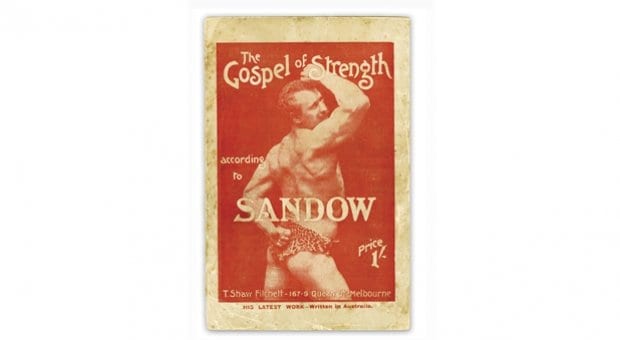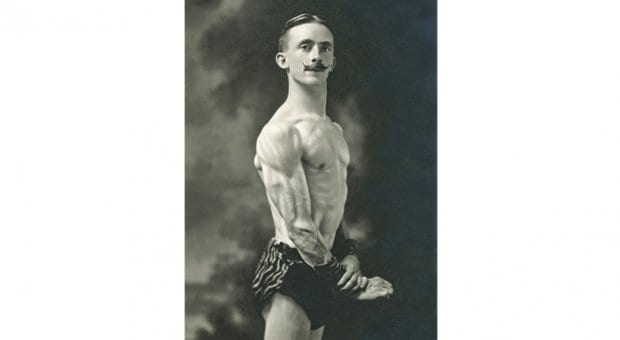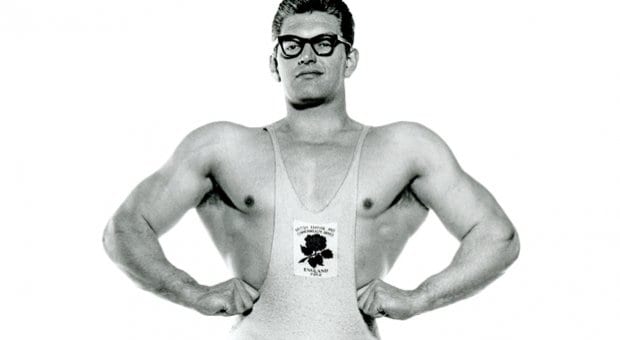
The cover of bodybuilder Eugen Sandow’s 1902 book The Gospel of Strength. Credit: Courtesy of Arsenal Pulp Press

AJ Chandos posed for this 1910 photograph at the newly opened Artona Studio in Vancouver. Chandos wanted a more impressive physique, so he asked the studio to paint in a few muscles for him, Universal Hunks author David L Chapman writes. Credit: Courtesy of Arsenal Pulp Press

According to Chapman, Sandow started the physical-culture craze of the 1890s — and was considered the “epitome of virility.” Credit: Courtesy of Arsenal Pulp Press
The first bodybuilding superstar, Eugen Sandow, so wholly believed the body is the physical expression of the soul that he titled his 1902 book The Gospel of Strength, reflecting the religious zeal with which he cultivated his formidable shape and travelled the world in the early 20th century. Amen!
Sandow “was at the start of the physical-culture craze of the 1890s, and he is the epitome of virility,” says Universal Hunks author David L Chapman. “More than any of the others, he knew how to use his muscles in a variety of creative ways.”
In a conservative era, Sandow pushed the envelope by alternately posing for the camera in leopard-print boxers, with a fig leaf covering his penis, and, if shot from behind, completely nude. The original bodybuilder pioneered not only the modern gym bunny, but the selfie-obsessed exhibitionism of those who enjoy documenting their physique as much as honing it.
It was Sandow who first inspired Chapman’s interest in bodybuilding, which has since led him to write three books on the subject: American Hunks, Venus with Biceps — which shows how the ladies can be hunky, too — and his latest installment, Universal Hunks, taking the flexing to a global level.
“Almost 40 years ago I found an old, rare cigar-box label from 1894 that had a glorious lithographed, embossed portrait of bodybuilder Eugen Sandow,” Chapman says. “I was immediately intrigued by the image, and I began to search for facts about the subject. I was rather surprised to learn that there had been many professional strongmen in the 19th century, and some of them were pretty colourful characters.
“Bodybuilders originally appeared in sideshows, and vaudeville had room for lots of really weird and wonderful performers. So I guess you can say that I was lured into the study of sport and athletics through the stage door.”
In the 1800s, nude photographs of male hunks were morally justified as “illustrations of healthy living” (which is what I’ve renamed my porn folder). Sports and physical health became a means to create national unity in European countries — a philosophy later adopted by Hitler in his belief that mastery of the self translated into control of the world. Chapman reveals how Hitler, in his quest to create a physically superior race of German people, transformed the image of the muscleman into an aggressive and violent figure with Nazi propaganda posters.
Through a visual odyssey of hard bodies, the hundreds of images in Universal Hunks depict the evolution of defined muscles as a means to not only define, but redefine cultures.
In his list of the five “greatest hunks of all time,” Chapman includes Japanese novelist Yukio Mishima, who, along with photographer Tomatsu Yato, “were at the centre of the new gay culture in Japan in the post-war years that turned away from femininity and softness and embraced hard muscularity and hyper-manliness.”
From colonization to fascism and from vaudeville to god, the male physique as the pinnacle of male beauty has for centuries been arousing awe, morale and other things worldwide.

 Why you can trust Xtra
Why you can trust Xtra


